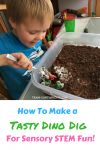Simple, Strange, and Fun Human Body Science Experiments to Wow Your Kids.
The human body has some strange quirks. I don’t mean things like passing gas. (Although my kids are firmly in the phase where they find that hilarious.) I mean the way we can move and how our muscles work. And you can trick your muscles too, making us think things are happening that aren’t. There are some simple activities to help demonstrate to your children how we can fool our bodies. They seem like simple parlor tricks, but there is real science behind them. So let’s wow your kids with 5 simple human body science experiments.

What's In This Post?
Human Body Science Experiments
When you think of strange human tricks you might be thinking of things like contortionists or people who can swallow swords. These aren’t that complicated. In fact, anyone can do them. The only thing you need for these tricks is your body, and maybe a helper. They are safe, but of course, if you or your child has some sort of physical limitation keep that in mind and take care. (Learn why these sorts of sensory activities are so important for children and their brain development—> The Big Benefits of Sensory Play)
Bet You Can’t Stand On One Foot

The Set Up
I bet you can prevent your child from standing on one foot, without even touching them. To start out have your child stand on one foot. For young toddlers, this can actually be challenging, but for preschoolers and up they can usually stand on one foot for a few seconds at least.
After you’ve established they can stand on one foot, move over to a wall. Have your child stand with one foot against the wall and one side right up against the wall. Have them try to lift the foot not against the wall and stand on one foot.
They can’t do it. You try it too!
The Science
Why can’t you stand on one foot that way? After you’ve tried (and failed) to stand on one foot while against the wall, step away and try again normally. Do you feel the subtle shift in your weight? When you lift one foot your center of gravity shifts to the side to compensate for the new position. Standing against the wall makes it impossible for your weight to shift, so you fall if you try to lift a foot.
Sticky Finger

The Set Up
Have your child put their fingertips on a table without their palms touching the table. Kind of like they are pretending to be a spider. Keeping the other fingers down, have them lift their thumb. Put it down. Lift the pointer finger. Put it down. Lift the pinky finger, and then put it down. Now lift the ring finger.
It’s pretty tough, isn’t it? Some people can get it up a little, but not as high and certainly not as easily as the other fingers.
The Science
Why is it hard to lift the ring finger? (And do things with it in general?) The ring finger and the middle finger share a lot of tendons. This makes it challenging to move them independently. When you hold your middle finger down on the table these tendons make it very hard to lift up the ring finger on its own.
Floating Arms
The Set Up
Have your child stand in a doorway with their arms touching each side. Then have them press into the doorframe as hard as they can for about a minute. (This one might be tough for younger children if they don’t quite get staying still and pressing hard for that long, but older children can experience this.) After a minute has passed have them step forward out of the doorway and watch their arms mysteriously float up.
The Science
Why do your arms float on their own? This is known as the Kohnstamm phenomenon. It is an involuntary contraction of the muscles after a prolonged voluntary contraction. Basically, you are choosing to press your arms against the doorway, this is the voluntary contraction. Once you step away your muscles maintain the contraction even though you have stopped trying to push. This is the involuntary contraction. You can repress this floating reaction by pressing your arms tightly to your side.
What is interesting is that this phenomenon has actually been highly studied. It currently appears that the lift signal can be blocked before it even reaches the muscles. This understanding of how nerves work could be helpful for conditions like Parkinsons or Tourettes.
Drop Your Arms Through the Floor

The Set Up
This is a two-person experiment. Have your child lie down on the floor, face down. Carefully lift their arms up. Lift them as high as is comfortable, but make sure their hips are still on the floor. Have your child relax their head forward and close their eyes. Hold that position for about a minute, then slowly lower their arms back to the ground. (Be careful not to knock their heads!) As you lower their arms to the ground it will feel as though their arms are going through the floor and sticking straight out in front of them, despite being in line with the rest of their body.
The Science
Proprioception. Alright, I’ll explain a bit more than that. Proprioception is your body’s way of figuring out where it is in space. You rely on all our senses, your muscles, and your nerves to know where your boy is positioned at any point in time. You can take away one sense, but still have a general idea of what is going on with your body. (Think you can touch your elbow. Then close your eyes and you can still touch your elbow because your other senses know where your body is.)
It is easy to fool yourself though. We tend to rely heavily on our sense of sight, so when that is missing it is easier to confuse your body. When you close your eyes and relax with your arms in the air you get used to your body in that position. As your arms are lowered your head touches the floor first and your arms keep going. Due to your lack of sight, your body tries to adjust its mental picture of where it is located in space. This results in feeling like your arms continue to move in front of you through the floor, even though they don’t actually do so.
Jump Forward If You Can

The Set Up
Have your child bend over and hold their toes, keeping their legs as straight as they can. Holding this position ask them to jump backward. Not too hard. Now have them try to jump forward. That is a lot harder, if possible at all. Keep trying because it’s fun.
The Science
Why can’t you jump forward as well as you can jump backward? This is another case for center of gravity. When you bend over and hold your toes your center of gravity is shifted backward, more over your rear end. When you want to move in a direction your center of gravity leads the way. With it behind you, it is very hard to move forward! Ben particularly like watching me try this one.
Questions To Ask
When you are doing these with your kids keep the conversation going! Ask questions. What do they think will happen? What did they observe while they did the experiment? Can they think of why the experiment did or didn’t work? What could they do differently? These questions as the start to the scientific method. No, this is not a stuffy outdated idea just meant for chemistry class. The scientific method teaches logical thinking and problem-solving. In fact, it teaches a lot of life lessons. (Learn about all the life lessons from the scientific method here–> Life Lessons from the Scientific Method.)

Human Body Science Is Fascinating
These are just 5 fun ways you can play with how your body works in and perceives the world. It is truly fascinating! And a lot of fun. Scientists are still learning so much about how we perceive the world and how our nerves and muscles communicate these perceptions with our brains. Understanding how these simple human body science experiments works helps us to get closer to solving the mystery behind many neurological diseases.











Laura
Monday 24th of September 2018
This is the coolest post!! What fun ideas! Definitely trying these with the kids.
Toni
Wednesday 22nd of August 2018
I love these activities! We are definitely going to do some human body experiments at our house!
Sarah
Monday 20th of August 2018
What fun these are. It's always nice to have simple activities to do with kiddos that engage them and make them interested in science.
Jennifer
Monday 20th of August 2018
These are great things that moms can use !
Jasmine Hewitt
Monday 20th of August 2018
I love these! bookmarking for when th kid is a little bigger